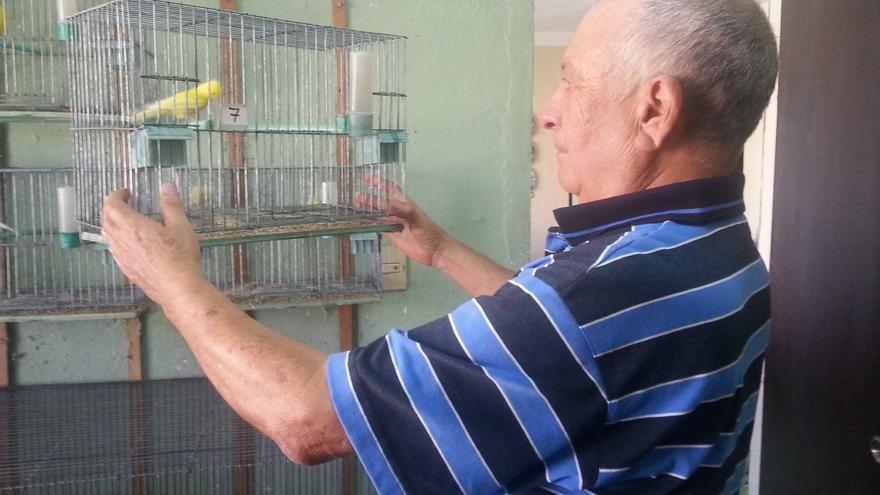
![]() 14ymedio, Carlos A. Torres Fleites, Santa Clara, 26 January 2018 — Luis Morales Torres has lived among the chirping for 40 years. This Villaclareño fell in love with breeding birds in 1967. Today, canaries, the main breed he works with, are not only his passion and main pastime, but a way to make a living. Like him, another 10,000 people throughout the Island breed more than 30 species of birds for sale, according to data from the National Ornithological Association of Cuba (ANOC).
14ymedio, Carlos A. Torres Fleites, Santa Clara, 26 January 2018 — Luis Morales Torres has lived among the chirping for 40 years. This Villaclareño fell in love with breeding birds in 1967. Today, canaries, the main breed he works with, are not only his passion and main pastime, but a way to make a living. Like him, another 10,000 people throughout the Island breed more than 30 species of birds for sale, according to data from the National Ornithological Association of Cuba (ANOC).
“Bird breeding today has become the economic sustenance of many families,” Morales Torres tells 14ymedio, adding that the economic difficulties that are experienced on the island have led many people to see this hobby as a lucrative business.
The best specimens of canaries can be purchased from breeders through the ANOC at a price of 6 Cuban convertible pesos (CUC) and those of lower quality are sold through pet stores for 4 CUC.
Across the Island, there are 17 Non-Agricultural Cooperatives (CNA) engaged in the captive breeding of birds, according to data from the National Office of Statistics and Information (ONEI). In all, there are 431 entities engaged in this work, which was authorized in 2013 when the state allowed cooperatives and self-employed individuals to engage in a new set of money-making endeavors.
Although it is a business that provides benefits to breeders, Morales Torres warns that “[it] is not easy to raise canaries because it is still expensive and takes a lot of dedication.” It is also a market not immune to risks, which include the mistakes of those who approach breeding for the first time.
At first, many of Morales’ birds died because he did not know how to prepare a substitute for the soft food that canaries give their young in the first days of life. In addition, he made the cages with thin branches and wands from the coconut palm tree because the costs of wire and wood wands were prohibitive.
With patience, the Villaclareño saved enough money to buy canaries that served as a genetic base for several generations of beautiful specimens. Even so, in the process of becoming a professional bird breeder there have been some bitter stumbles along the way, such as the loss of some animals preyed on by mice or the hard years of the Special Period in the 1990s — after the collapse of the Soviet Union and the loss of its subsidies for Cuba — when “nobody bought a bird because of the cost and delicacy” associated with taking care of them.

Currently, caring for only one of these animals still requires a large initial investment, since the owners feed their canaries eggs. Between them, four or five canaries can consume an egg a day, and given the shortage of this product on the island after Hurricane Irma, the breeding process is ever more complicated and expensive.
In addition, preparing other mixtures to feed the birds, made from a base of grain, sunflower seeds, millet or birdseed can mean a disbursement of 50 Cuban pesos every 20 days to support 15 canaries, but owners with fewer resources measure out this formula so that the preparation lasts longer.
Morales Torres, who was vice president of thecolored canaries group in the Ornithological Association of Villa Clara, appears to be a very careful breeder. In his bird farm he moves slowly among the cages, feeds some, looks at others carefully and checks that everything is clean and comfortable for his colorful animals.
The breeders’ clients are very diverse people, ranging from private business owners who want to decorate their premises, to families that acquire them because they “sing very beautifully,” especially the males. Also, many parents bring their children to pet stores seeking a first animal for them to care for.
But on the Island, the commercialization of birds in captivity is not only a business to satisfy the internal demand. In Artemisa, The House of the Birds is one of the CNA’s dedicated to the sale of ornamental birds, including their export and import thanks to a resolution of the Ministry of Agriculture. The breeders that are part of the cooperative keep 60% of the revenue from sales with the remaining 40% going to the coffers of the State.
During 2016, this cooperative exported 4,817 birds, with the species most in demand being parrots and roseicollis. The destinations of the shipments included countries such as Mexico, Canada, Guatemala, Panama, Venezuela and Honduras, and others as infrequent as North Korea.
As an experienced breeder, Morales is committed to changing the mentality, especially among “older people” and taking advantage of the fact that many countries are interested in acquiring Cuban birds “for export and also to acquire products and technology that allows them to improve this hobby.”
_______________________________
The 14ymedio team is committed to serious journalism that reflects the reality of deep Cuba. Thank you for joining us on this long road. We invite you to continue supporting us, but this time by becoming a member of 14ymedio. Together we can continue to transform journalism in Cuba.
